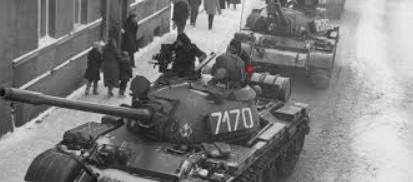Poland

Фото: Борис Бабанов
Russian troops in Eastern Europe in late 1989. Right on the Polish border, threatening to invade
Under the threat from the USSR, the Polish government decides to crack down on the protests by declaring martial law. The Polish Peoples Army cracked down on the protesters and threw them in jail. This led to the USA, Britain, Canada, and other Western powers sending financial aid to Solidarity Trade Union. The Polish government had a significant problems maintaining martial law, as their military rank and file primarily consisted of conscript soldiers, which they did not pay at all. On a number of occasions soldiers joined the striking workers. Needless to say, martial law started to fall apart when the soldiers couldn't afford food. With the threat of the military revolting against the Polish government, the Polish leadership ended martial law. They were forced to let Solidarity become an official party and adopt a democratic system of government.